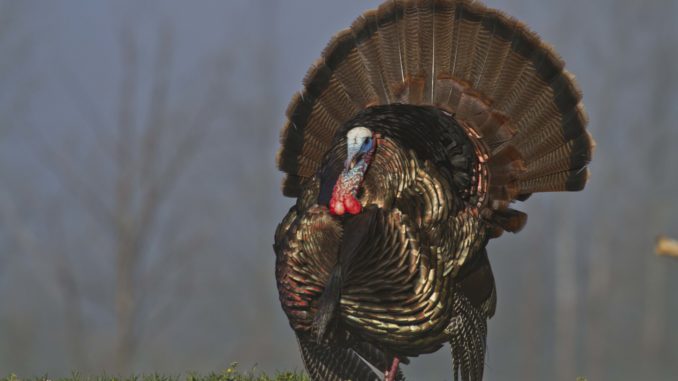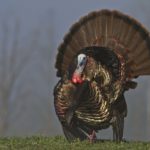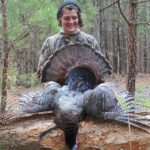
What does spring gobbler season hold this year in the Carolinas? In both states, things are looking up.
Ben Franklin was really onto something. Back about 250 years ago, he opined after the fact that the wild turkey was “a more respectable bird” than the bald eagle chosen to become a national symbol.
No, he didn’t suggest that the turkey replace the eagle, just that it was a “true original native” of American, “a bird of courage” that might chase a redcoat soldier out of its farm yard if one dared to enter, while the bald eagle was basically a lazy scavenger.
Well, things have worked out pretty good for both birds. The eagle has become the symbol of everything that’s good about the United States, and the wild turkey has become the nation’s most-popular gamebird, whose throaty gobble is a harbinger of spring.
Across the Carolinas, tens of thousands of hunters will enter the woods over the three or four weeks, their sole desire to do battle with a gobbler on its own terms and carry it home at the end of the day.
What is it that affects hunters who spend five or six weeks a year, thinking of nothing but hearing the next gobble? The late Ben Lee once described turkey hunting this way: “It’s a disease.” Tom Kelly, the brilliant Alabama turkey hunter and writer, captured what Lee meant when he said he doesn’t hurt turkeys because he wants to, but because he has to, caught in the grips of the stately lord of forest or swamp.
So what will this spring’s season bear? In North Carolina and South Carolina both, there’s reason for optimism — at least a little bit.
North Carolina
North Carolina has two turkey seasons: April 1-7 for youths under age 16, and the statewide season for all hunters, April 8-May 6. The bag limit is one turkey per day, two per season, with only bearded birds allowed.
Last season, North Carolina hunters recorded the second-highest harvest on record, 17,932 birds; the record of 18,409 was set in 2013. Those numbers would have seemed impossible back in the 1970s, when the N.C. Wildlife Resources Commission began a program to restock birds across the state.
“Originally, back in the 1970s, Wayne Bailey (then the NCWRC’s wild-turkey project leader), put out a goal of having a statewide flock of 20,000 birds that would support an annual harvest of 2,000; that was the perspective in the 70s,” said Chris Kreh of Elkin, the Commission’s upland game bird biologist.
“During the whole restocking program, we learned a lot about turkeys. We found out that turkeys are a lot more adaptable, that the best habitat is a mixture of agriculture, pastureland and forested land — more diverse habitat.”
The Commission estimates that the statewide flock numbers 265,000, with seasons open in all 100 counties.
“I think the flock is still expanding in the southeastern part of the state,” Kreh said. “And last summer, the coastal area had a better hatch than the rest of the state.”
Turkey has trouble raising broods last summer, as the Commission recorded its poorest summer brood survey on record: an average of 1.5 hens per poult.
“Last year’s (poor) hatch will play out a little beginning in 2018 when that crop is 2-year-old birds,” Kreh said. “I expect a pretty good harvest this year. I don’t think we’ll set another record, but I think it should be good. I don’t expect to see many jakes killed this year. The last two hatches weren’t great, but they were better than last year’s.”
Southeastern counties have taken over from Piedmont counties in terms of total harvest. Pender County, a big, agricultural county that was part of the Commission’s last stocking efforts, produced 487 birds last year, slightly ahead of Rockingham County’s 484 birds, which led northern Piedmont counties. Two more southeastern counties, Duplin and Craven, ranked fourth and sixth. The rest of the top 10 was spread among counties along the Roanoke River, the northern Piedmont and the Foothills.
Last summer’s brood survey told biologists at least one thing: the state’s flock is in good shape, as far as gobblers are concerned. Statewide, the number of gobblers observed was .57 for each hen, with .50 considered a healthy percentage. Counties in the eastern third of the state had the best percentage, .63.
“I’m encouraged by the number of gobblers in the survey,” he said. “It tells us we’ve got a good number of gobblers, that we’re not hitting them too hard.”
South Carolina
After a long period of decline, South Carolina hunters had a better season in 2016, with the harvest increasing around 10 percent to 16,783 birds. Charles Ruth, the biologist who is the deer and turkey project leader for the S.C. Department of Natural Resources, said the 2017 spring season hopes for more of the same.
“The die was cast in 2013 for the poor season we had in 2015, because of poor reproduction. It’s about a two-year cycle,” Ruth said. “Reproduction was a little better in 2014 and 2015, and that showed up in the harvest last year. I fully expect it to show up again this spring. We’ve got it going in the right direction. You look at the harvest two years later to reflect the hatch.”
South Carolina hunters who hunt on private land will have a March 20-May 5 season, while those hunting on Wildlife Management Areas (WMAs) can hunt from April 1-May 5. The bag limit is two birds per day and three per season, with bearded birds only.
Hunters took 16,783 birds last season, and during the summer brood season. Hens raised an average of 1.8 poults, with a high of 2.2 in the Lowcountry
Top counties in terms of total harvest were scattered across the state, from No. 1 Wiliamsburg with 936 birds to No. 10 Newberry with 484. Counties from every corner of the state were represented, from the Lowcountry to the Grand Strand, the Midlands and Upstate.
“We’re not back to where we used to be, but it’s looking a little better,” Ruth said. “If we can continue this trend of having a ‘little better reproduction’ for a couple more years, it might be a step in the right direction.”
Ruth has said on a number of occasions that it’s probably a combination of a number of factors that have negatively affected South Carolina’s statewide deer herd and turkey flock since the high-water mark in the early 2000s.
“If some of the factors we think have combined in the decline, a loss of habitat and predation, if we were right, I don’t know how that has changed the past two years,” he said. “I think our (harvest and brood-survey) numbers are still bouncing around.”
Ruth said it will take several more years studying harvest figures to determine how much South Carolina’s turkey season dates and reduced bag limit, which took effect in 2016, might be factoring into the health of the statewide flock.
“I’d like to have a few years to look at before we start talking about that,” he said.






Be the first to comment